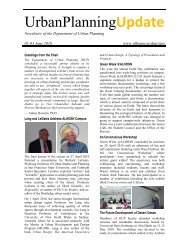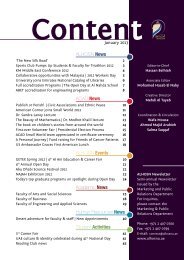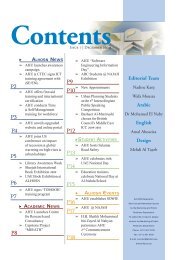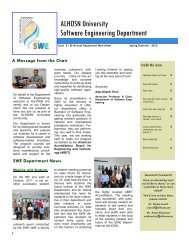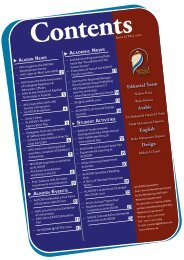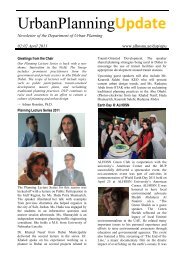ALHOSN University Catalogue Global Knowledge with Local Vision ...
ALHOSN University Catalogue Global Knowledge with Local Vision ...
ALHOSN University Catalogue Global Knowledge with Local Vision ...
Create successful ePaper yourself
Turn your PDF publications into a flip-book with our unique Google optimized e-Paper software.
INT 471 Furniture, Decorative Styles, Textiles and Accessories (3 = 3 + 0)<br />
Prerequisite: DES 102, INT 107<br />
This course introduces the student to the underlying principles and theory of the decorative arts and crafts periods,<br />
proceeding, during, and following the impending industrial revolution. The course establishes key philosophies<br />
associated <strong>with</strong> movements, and is discussed through the analysis of the work of key designers and architects of<br />
the period, and their related theoretical approaches. Course material covers a broad range of interior, furniture,<br />
object, and furnishing examples.<br />
INT 472 Sustainable Interior Design Practices (3 = 2 + 1)<br />
Prerequisite: INT 301<br />
Designers today utilize more sustainable materials that are responsible, ecological design solutions. This course<br />
focuses on the issues, practices, materials and applications that are eco-friendly solutions, and techniques to<br />
provide more self sufficient, environmentally responsive designs. Students will explore such topics as: the<br />
degrading environment, sensitivity, leadership, ethics and responsibility in the context of sustainability. Areas of<br />
focus <strong>with</strong>in Interior design such as air quality and pollution, urban sprawl, deforestation and resource depletion,<br />
sick building syndrome, material off-gassing and CO2 emissions, as applicable in design applications will be<br />
discussed as methods of ecological accountability and practice.<br />
INT 473 History of Design 2 (3 = 2 + 1)<br />
Prerequisite: FAS 102, FAS 103, DES 102, INT 107<br />
This course examines the major principles advocated throughout the modern movement focusing on key examples<br />
in the context of their political, philosophical, and economic climates. This course examines the principles,<br />
philosophies and theory behind architecture, furniture, artifacts and interior work during this period of 1930 -<br />
today, that have become the fundamentals of key design approaches.<br />
INT 474 Furniture Design and Detailing (3 = 3 + 0)<br />
Prerequisite: INT 301<br />
This course aims to develop the students' appreciation of the social, cultural and philosophical issues that inform<br />
the discipline of furniture design and investigates current approaches and market concerns. Within this context,<br />
technology and process, structural possibilities, material characteristics and production issues will also be<br />
examined. The course focuses on developing the student's vocabulary of furniture, lighting and fittings in<br />
conjunction <strong>with</strong> the materials.<br />
INT 475 Theatrical Design and Detailing (3 = 3 + 0)<br />
Prerequisite: INT 301<br />
Design for cultural venues and entertainment is a key area of Interior Design today. This course explores design<br />
of both the theatre and entertainment environments, and design for the stage performance itself. As a primer of<br />
theatrical design, sceno-graphic design and production, techniques associated <strong>with</strong> the staged set, lighting,<br />
acoustics, background sets, and other elements specific to performance spaces are discussed, in the context of<br />
Interior architectural design.<br />
INT 476 History of Design 3 (3 = 2 + 1)<br />
Prerequisite: FAS 102, FAS 103, DES 102, INT 107<br />
This course examines contemporary design issues and approaches in architecture, interior design and art in the<br />
western world. Emphasis on understanding current pluralism expressed in the renewed interest of humanism,<br />
contextualism, ornament, historicism, and industrial pop movements. The Interior design profession is explored<br />
from its early successors to today; discussing key current practitioners such as Philippe Starck, and other<br />
leading designers such as Frank Gehry, Charles Moore, Arata Isozaki, and Robert Stern to name a few.<br />
INT 477 Design for Health Care and Aging (3 = 3 + 0)<br />
Prerequisite: INT 107, INT 301<br />
Design for the Healthcare environment is a crucial area of design today requiring more in-depth knowledge of<br />
the related issues, support, equipment and general conditions of medical and care spaces. Relevant topics<br />
such as ambulatory accessibility, patient space requirements, universal design approaches, design for specific<br />
disabilities, and basic design responsibility for the aged are covered.<br />
INT 478 Sensory Environments: Technology in Contemporary Design (3 = 3 + 0)<br />
Prerequisite: INT 301<br />
This course examines the influences and effects of emerging communication systems and building technology<br />
strategies, and building and furniture systems, in the context of the human interactive experience, and<br />
environmental concerns of our physical surroundings. Interior architecture is traditionally articulated and<br />
understood by the physical and static elements of walls, roofs and floors. An addition more qualitative approach is<br />
132





